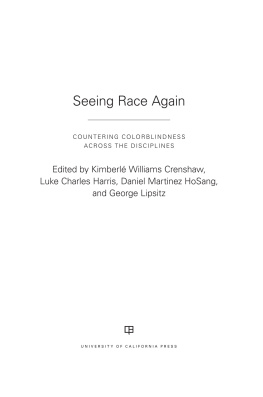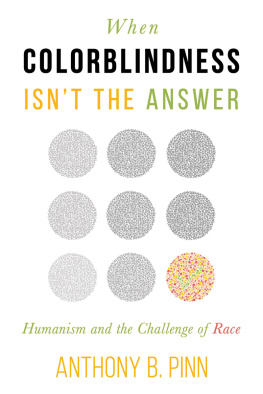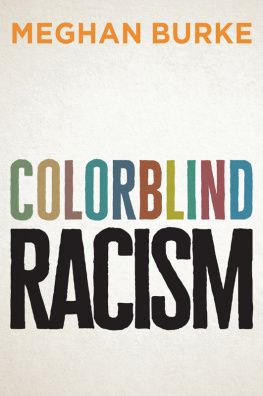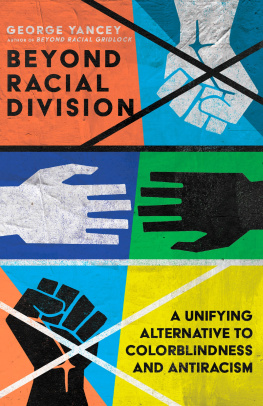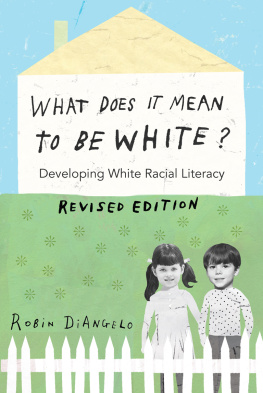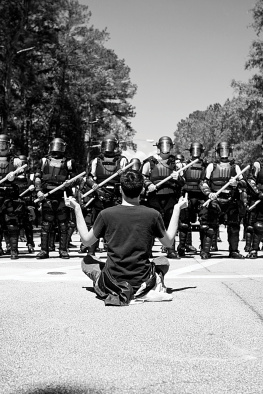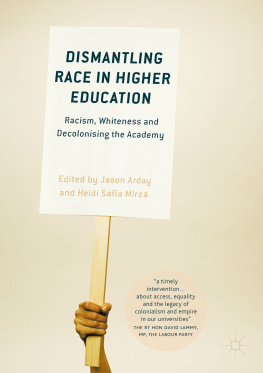The publisher and the University of California Press Foundation gratefully acknowledge the generous support of the Atkinson Family Foundation Imprint in Higher Education.
Seeing Race Again
COUNTERING COLORBLINDNESS ACROSS THE DISCIPLINES
Edited by Kimberl Williams Crenshaw, Luke Charles Harris, Daniel Martinez HoSang, and George Lipsitz

UNIVERSITY OF CALIFORNIA PRESS
University of California Press, one of the most distinguished university presses in the United States, enriches lives around the world by advancing scholarship in the humanities, social sciences, and natural sciences. Its activities are supported by the UC Press Foundation and by philanthropic contributions from individuals and institutions. For more information, visit www.ucpress.edu.
University of California Press
Oakland, California
2019 by The Regents of the University of California
Library of Congress Cataloging-in-Publication Data
Names: Crenshaw, Kimberl, editor. | Harris, Luke Charles, 1950 editor. | HoSang, Daniel, editor. | Lipsitz, George, editor.
Title: Seeing race again : countering colorblindness across the disciplines / edited by Kimberl Williams Crenshaw, Luke Charles Harris, Daniel Martinez HoSang, and George Lipsitz.
Description: Oakland, California : University of California Press, [2019] | Includes bibliographical references and index. |
Identifiers: LCCN 2018035602 (print) | LCCN 2018041744 (ebook) | ISBN 9780520972148 (epub and ePDF) | ISBN 9780520300972 (cloth : alk. paper) | ISBN 9780520300996 (pbk. : alk. paper)
Subjects: LCSH : Racism in higher educationUnited States. | Multicultural educationUnited States. | Post-racialismUnited States. | Race discriminationUnited States. | United StatesRace relations.
Classification: LCC LC 212.42 (ebook) | LCC LC 212.42 . S 44 2019 (print) | DDC 344/.0798dc23
LC record available at https://lccn.loc.gov/2018035602
Manufactured in the United States of America
26 25 24 23 22 21 20 19
10 9 8 7 6 5 4 3 2 1
CONTENTS
Kimberl Williams Crenshaw, Luke Charles Harris, Daniel Martinez HoSang, and George Lipsitz
Kimberl Williams Crenshaw, Luke Charles Harris, Daniel Martinez HoSang, and George Lipsitz
George Lipsitz
Kimberl Williams Crenshaw
Dwanna L. McKay
Marzia Milazzo
Kimberl Williams Crenshaw
Loren Kajikawa
Barbara Tomlinson
Devon W. Carbado
Leah N. Gordon
Luke Charles Harris and Uma Narayan
Glenn Adams and Phia S. Salter
Aileen Moreton-Robinson
Felice Blake
Paula Ioanide
Milton Reynolds
PREFACE AND ACKNOWLEDGMENTS
PRAYING TO THE DISCIPLINARY GODS WITH ONE EYE OPEN
This volume is the culmination of more than a decade of shared inquiry involving dozens of scholars investigating the origins, evolution, and consequences of racial colorblindness as a metaphor for social relations across the academic disciplines. Its genealogy, however, reaches beyond the academy both to the Civil Rights Movement, which briefly shook the foundations of American social life, and to the demobilizing campaigns within the legal and political arena to restabilize the American social order in its aftermath. Anchoring the slowed pace of race reform in the 1980s, and the dismantling of the civil rights infrastructure throughout the 1990s, colorblind rhetoric crossed over into popular culture to provide ideological cover for ballot initiatives and other efforts to neutralize affirmative action and other antisubordination measures.
Despite its solidly conservative deployment in the postcivil rights era, colorblindness received an unexpected rebranding in 2008 as the ideological standard-bearer for the countrys postracial future. This was a remarkable ride for a concept that defied definition, measurement, or theorization. Indeed, the work that colorblindness does across so many sectors and issues is stunning given the utter lack of consensus as to what it really is. Unanswered questions about whether it is a social theory, a moral imperative, or merely a rhetorical prophylactic have not significantly undermined its uptake by institutions and pundits ranging from liberals who hold it as a transcendent ideal to organizations whose assault on university policy marches under this banner. Descriptive questions about whether human beings can actually choose to be colorblind or whether it is a cognitive impossibility only complicate the more fundamental question about whether it can produce a more just and legitimate social world. The feeble justification for colorblindness seems incongruous with its ubiquitous presence in public discourse pertaining to race and the social world.
This anomalous reality formed the centerpiece of a research initiative that moved from the affirmative action battlefields of California, Michigan, and Washington to the Center for Advanced Study in the Behavioral Sciences (CASBS) and the Center for Comparative Studies in Race and Ethnicity (CSRE) at Stanford. The African American Policy Forum (AAPF) had been involved in campaigns in multiple states to preserve race-conscious policies, working together with the American Civil Liberties Union (ACLU) and other organizations to bring cross-disciplinary research to bear on the enduring nature of racial inequality in American society. The dominance of colorblindness as the embodiment of racial justice underscored the need for a powerful counternarrative that could convey an alternative vision of racial equity, one tied to the historical and contemporary ways that race actually worked as opposed to the fantasies of racial transcendence peddled by critics such as Ward Connerly and organizations like the Center for Individual Rights. The idea that the commonsense appeal of colorblindness could not be directly countered to defeat popular initiatives to undermine equal opportunity policies was underscored by the conventional messaging experts who encouraged a version of a mend it, dont end it approach. Campaign messaging in defense of affirmative action largely sidestepped racial matters to foreground the presumably more palatable case of gender equity.
With the exception of Colorado, the campaigns designed to defend racial justice and affirmative action without acknowledging racial injustice went down to withering defeat. Without a powerful counternarrative, the easily inflated rhetoric of colorblindness proved to be a trap for liberals. For critics of civil rights, colorblindness served as a battle-tested Trojan horse, one that could deliver easy reversals of the painstaking victories that courageous Americans had risked everything to secure. Under the magic of the colorblind trope, historically marginalized communities were reframed as illegitimate beneficiaries of reverse discrimination while those who inherited the advantages of a society built, as Justice Harlan approvingly observed in Plessy v. Ferguson, on the superiority of whites were lifted up as victims. As Luke Charles Harris notes, through this classic misdirection the diminished overrepresentation of whites became the critical civil rights issue of the postcivil rights era.
The yawning losses sustained by civil rights constituencies and the troubling future that lay ahead prompted the editors of this collection, both individually and collectively, to mobilize knowledge to reveal the contemporary workings of racial power. Daniel Martinez HoSangs Racial Propositions: Ballot Initiatives and the Making of Postwar California, for example, uncovered the connections between Californias antiaffirmative action and anti-immigrant campaigns and midcentury efforts to use popular initiatives to reverse civil rights victories. HoSang reveals how Californias long history of subjecting minoritized racial groups has long been rationalized by appeals to race-neutral values like freedom and choice. George Lipsitzs work interrogating power and resistance stretched across sociology, history, and Black Studies. Luke Charles Harriss trenchant critiques of both constitutional jurisprudence and political science revealed the otherworldly dimensions of a constitutional and political theory of equality that failed to center white supremacy as its starting proposition. And Kimberl Williams Crenshaws work as a founder of Critical Race Theory took up the ways that the racial revolt against white supremacy had been depoliticized and tamed by liberal legalism. The common denominator in all of these projects was their focused interrogation of the profound contradiction between abstract American ideals of equality divorced from social reality and the messier story of how racial power is constituted and reproduced through colorblind tropes and stealth performances.

